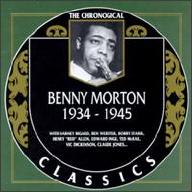Despite all his fantastic contributions to landmark recordings, Benny Morton just isn't that well-known a name among jazz fans, unless one is talking to trombonists. He had a huge influence and has been cited as one of the great players by the likes of Kai Winding, Bill Watrous, and Eddie Bert, all top-flight doctors of the bone. The latter man even stopped Morton on the street outside a club and asked him for lessons. Morton obliged, inviting the then star-struck young man backstage to meet his heroes in Basie's band. He began playing trombone as a child, picking up most of his knowledge on his own. The Jenkins Orphanage Band was his first ensemble experience, although it is not clear whether the man himself was abandoned, which has been known to happen if parents get wind that their child might grow up to be a jazz musician. The trombone soloist in Mamie Smith's band, Dope Andrews, is said to be the first jazz player who caught Morton's ear. In 1923, Morton joined Clarence Holiday's band. Three years with this outfit and he was ready to take on membership in the innovative Fletcher Henderson band, the first of a series of first-rank big bands that he would join, usually for extended stays. He was with Don Redman for six years and Count Basie for three, getting in on many Billie Holiday recording sessions that a handpicked crew of Basie alumni were involved in. He also worked with the orchestra of Chick Webb. Another notable credit was in the orchestra recordings of composer and arranger Raymond Scott, whose work was often used as the background for cartoons. In 1940, he made the transition toward smaller combos, becoming a member of a sextet led by pianist Teddy Wilson. This group has a reputation as one of the superior swing bands of its time and a great vehicle for the leader's abilities both as a pianist and a bandleader. In 1943, Morton joined another small band, this one led by Edmond Hall. One of the few dates with Morton as a soloist was done in the early '40s, a 78 for Columbia that was a kind of trombone special. Morton had the A-side with his rendition of the Gold Digger's Song, better-known as We're in the Money, while the flip side featured fellow trombonist J.C. Higginbotham and the accurately titled Hot Trombone Blues. Morton left Hall's band with designs on starting his own outfit, which he kept going for a few years before seeking the economic protection of employment in New York theater pit bands. Through this, he connected with many radio and recording studio band jobs, which largely kept him busy through the '50s and '60s. This type of career sometimes heralds the end of a player's involvement with creative jazz, but Morton kept his slide in with record dates involving players such as trumpeters Buck Clayton and Ruby Braff. There was enough work on the jazz scene by the end of '60s to allow him to focus totally on swinging, and his accomplishments tell the story of a trombonist going out in a blaze of glory. He wasn't concerned with in-fighting amongst various branches of the swing genre and played happily with many artists of his generation. The Saints Sinners band put him together with swing veterans such as Yank Lawson, Bob Wilber, and Bud Freeman. These seasoned jazz pros enjoyed the good life on tour, dining on gourmet sea food while gigging at the Pescara Jazz Festival in Italy in 1974. The Top Brass tour combined Morton with Clark Terry, Bob Brookmeyer, Doc Cheatham, and Maynard Ferguson to create a comprehensive overview of jazz brass, backed by a British rhythm section. He also worked with Wild Bill Davidson, Bobby Hackett, and Sy Oliver. Morton's collaborations were too numerous and wide-ranging to be collected all in one place, but the Melodie Jazz Benny Morton 1934-1945 definitely pulls in some choice stuff, including dates with drummer Big Sid Catlett, trumpeter Henry Red Allen, clarinetist Barney Bigard, and tenor sax king Ben Webster. Morton's side of the Columbia single is included on this set. The Mosaic series also created a re-release collection of the Blue Note Swingtets, a project Morton created with clarinetist Jimmy Hamilton that also featured swing maestros Tiny Grimes and Ike Quebec. ~ Eugene Chadbourne, Rovi
Benny Morton
from New York, NY
January 31, 1907 - December 28, 1985 (age 78)
Biography
The trombone was a particularly effective musical device in swing music, and not only for its slurs, slides, growls, and groans. Benny Morton was known for his beautiful tone, advanced use of chromatics outside of the key signature, and tasteful understatement. He took part in much of the essential music of the swing period; in fact, listeners undertaking an exploratory journey into the heart of swing music will run smack dab into the man wherever they may turn. For example, dig into the limited but miraculous discography of innovative electric guitarist Charlie Christian and Morton is right there bopping along. One doesn't have to be a jazz fan to appreciate the '30s and '40s recordings of vocalist Billie Holiday and Morton is one of the many great players whose contributions make these sides such pearls. He played with Fletcher Henderson and Count Basie and was the member of several of the best swing revival bands from later decades. He kept being invited out on choice gigs well into his '70s, yet tends to be seen as an undersung hero.
Top Tracks
Albums
Videos
Close












